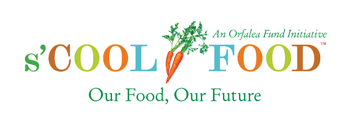We recently had the opportunity to sit down with Kate Adamick, the Food Systems Consultant for the s’Cool Food Initiative, to talk about her work and insights into transforming school food systems. With years of experience in the field, Kate is a passionate advocate for improving school meals and promoting sustainable, healthy food choices in schools across the nation.
When asked about her role with the s’Cool Food Initiative, Kate explained that her primary focus is on helping school districts navigate the complexities of transitioning to healthier, more sustainable meal programs. “The idea is to create a food system that’s not only better for the kids but also for the environment,” she said. “It’s about making sure schools have access to fresh, nutritious ingredients and the tools they need to prepare meals from scratch.”
Kate works directly with school food service teams, guiding them through the process of implementing changes, from sourcing local ingredients to providing culinary training for kitchen staff. “One of the challenges is breaking away from the reliance on processed, pre-packaged foods. But once we empower school kitchens to cook from scratch, the results are incredible.”
We asked Kate why scratch cooking is so important to the initiative’s mission. “Scratch cooking gives school kitchens control over what goes into the meals. That means fewer preservatives, additives, and unhealthy ingredients,” she explained. “It also allows for more flexibility in meeting the specific nutritional needs of students.”
In addition to improving the quality of food served, scratch cooking fosters a stronger connection to local food systems. Kate pointed out that many of the districts she works with are adopting farm-to-school programs, sourcing fruits, vegetables, and other ingredients from local farmers. “When kids see that their meals are made from fresh, local ingredients, it creates a sense of pride and curiosity about where their food comes from.”
Kate was candid about the challenges she faces in her work, particularly when it comes to budget constraints and staff training. “School districts often don’t have a lot of money to work with, so we have to get creative,” she said. “That’s where training and support come in. It’s not just about changing the food, it’s about changing the mindset.”
She also noted that the transition to healthier meal programs can be met with resistance from students accustomed to less nutritious, highly processed options. “It’s a gradual process. You can’t expect kids to suddenly love kale salads overnight,” she laughed. “But over time, we’ve seen that when you expose students to fresh, tasty food, they come around.”
As our conversation came to a close, Kate expressed optimism about the future of school food reform. “There’s a growing awareness of how important it is to feed kids well, and more and more districts are recognizing that healthy school meals are an investment in their students’ well-being and academic success.”
She hopes to see the s’Cool Food Initiative continue to expand its reach, helping schools across the country implement lasting changes to their food systems. “It’s about creating a new standard for school meals, where fresh, healthy food is the norm, not the exception.”
Through her work, Kate Adamick is helping to lay the foundation for a healthier future, one school meal at a time. Her dedication to empowering schools and promoting sustainable food practices is an inspiration to all who care about the health and education of our children.

